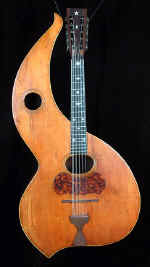

Size comparison with standard Knutsen harp
mandolin



|
In May of 2004, a Larson collector and I had a little
eBay bidding war on this fellow (I won, but ouch!) - he, because
he was convinced it was a Larson - I, convinced it was a Knutsen or at least
involved Knutsen in some way. When I received the instrument, I could
immediately tell that Knutsen didn't build it (double-ouch!). After sending images to others knowledgeable
about Larsons, we all agree that the Larsons are the best candidate. But the
questions abound: why, when, how?
The instrument appears to be all-original, other than a top repair, and is
well-played (and sounds incredible). There is no indication that there was ever
a label. It is ~33" in overall length, 16" at the widest part of the
body, 4" deep, and has a scale length of 18-1/4". With ten strings (using
standard tiple tuners) strung in pairs, the scale suggests a combination of
tenor and octave mandola - though the nut and bridge grooves don't seem to
display evidence of having been tuned in fifths. It has a spruce top and nice
mahogany back and sides. The 3-piece neck is maple with a dark center stripe,
the headstock is veneered asymmetrically with mahogany and ebony(?). The
inside back seam looks identical to my Dyer harp guitar. It reminded
Bob Hartman more of early Larsons, suggesting an early 1900s build, though I
imagine a later or even 'teens creation. |






|
|
In no particular order, here are my observations and opinions on the Knutsen
and Larson characteristics:
- Compared to Knutsen's "Lower Bass Point" harp mandolins, the
body is unmistakably similar, if not an exact, deliberate copy.
- Knutsen was the restless experimenter, and made multi-course instruments -
including the Harp Bandurria and a reported "10-string harp
mandolin" not yet in Inventory.
|

Knutsen "Lower Bass Point" harp mandolin, c.1910
|
- The trapeze tailpiece is identical to the one added (at an early date) to
my Knutsen Symphony harp guitar.
- Dyer had his own established line of harp mandolin family instruments.
- The 3-piece neck is considered an early Larsons feature, though there are
plenty of Knutsen harp guitars with 3-piece "striped" necks.
- The instrument has a full heel (other than one Knutsen mandolin with a
short heel, they all have butt joints).
- The center back brace is horizontal, not slanted like nearly all Knutsens.
|

My 1898-1900 Knutsen
has an identical (added) tailpiece.
|
- The fingerboard binding ends above a visible line of ebony underneath -
though when I peeled back the binding edge enough to check, it appear to be
a shim, not a single piece, as reported in Larsons.
- It is braced "under tension" (slightly convex) as Larsons were,
but then, so are my Knutsens.
- Any other details I can check, please write me.
I don't know what to make of this instrument, but I am sure there is a
story here!
Is it possible that the close "awareness and symbiosis" of the
Knutsen/Dyer/Larsons triumvirate that I mention on my Dyer mandolin and harp
guitar pages is at
work?
Could Dyer have received a customer request for "large 5-course Knutsen
mandola" - and had the Larsons build it?
Was Knutsen involved in the design, concept, approval, or at all?
This marvelous old instrument sings beautifully, but is otherwise not talking.
|